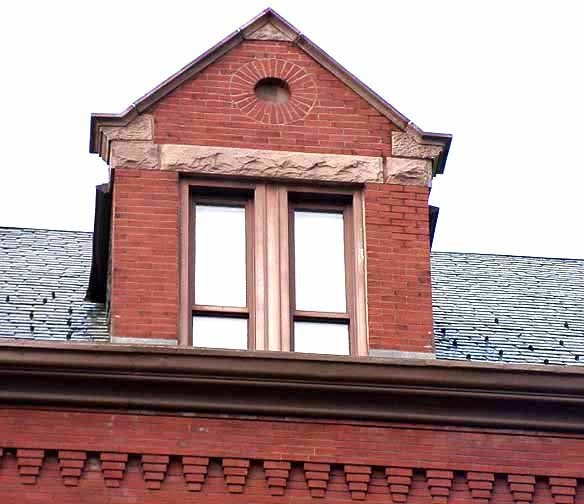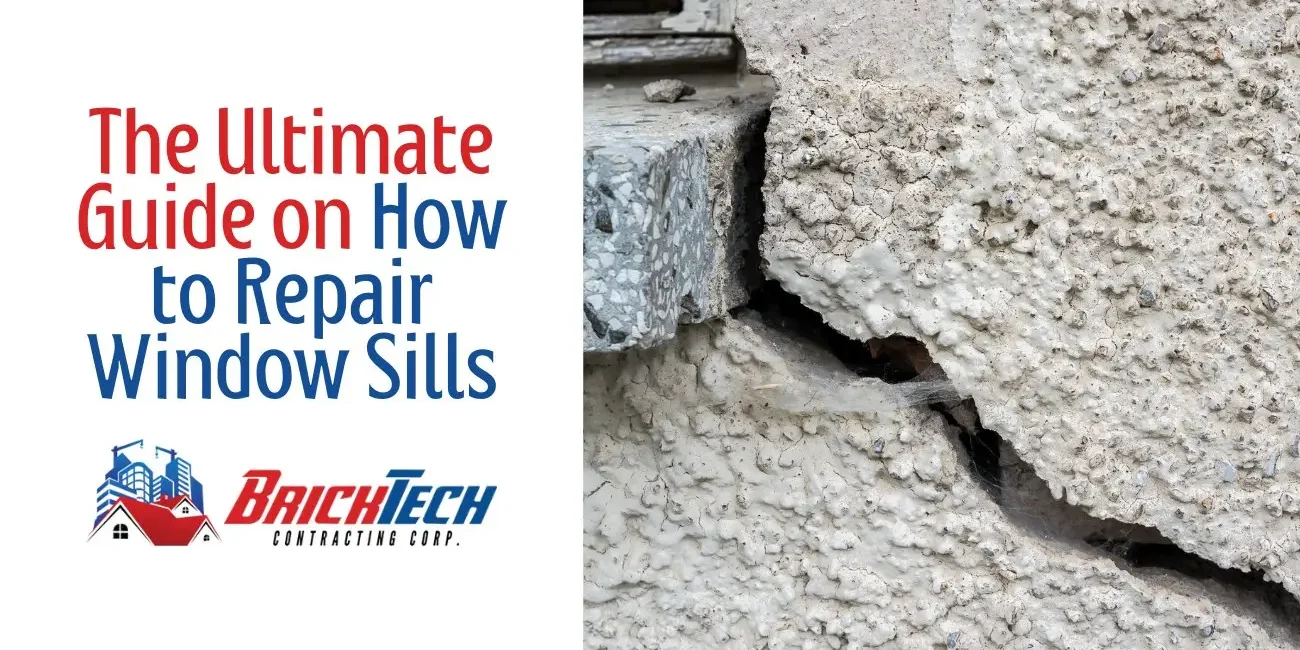Window sills are an essential part of any home, providing structural support and contributing to the overall aesthetics of your property. They are often made of brick or concrete, materials known for their durability but still susceptible to damage over time. Especially for brick and concrete window sills, proper maintenance and repairs are crucial to ensure the health and longevity of your windows. This guide will walk you through understanding, identifying, and repairing window sill issues, providing valuable information on how to repair window sills yourself for minor problems. It will also highlight situations where consulting a qualified masonry contractor in NYC, like Brick Tech Contracting Corp, is essential.
Understanding Window Sills
Before diving into repairs, it’s crucial to understand the different parts of a window sill and the materials commonly used in their construction. A typical window sill consists of the following components:
- Stool: The flat, horizontal part where the bottom sash rests when the window is closed.
- Apron: The decorative trim beneath the stool.
- Trim: The molding that surrounds the window, enhances its appearance and sealing gaps.
Materials commonly used for window sills include wood, vinyl, aluminum, and stone. This guide focuses primarily on brick and concrete window sills, which require specific expertise for repairs due to the nature of the materials.
How to Repair Window Sills – DIY & Pro Helps

Identifying Common Window Sill Issues
Visible signs of damage are often the first indicators that your window sill needs attention. Here are some common problems to look out for:
- Rot (Wood Sills Only): Soft, spongy wood caused by moisture exposure.
- Water Stains: Discoloration or watermarks indicating leaks, which can be a sign of water leaking under the window sill.
- Cracks: Small fractures due to age or environmental stress.
- Peeling Paint: Flaking paint often caused by moisture issues.
- Spalling Brick: Deterioration and crumbling of the brick surface.
- Cracked Concrete: Cracks in the concrete sill.
These issues can result from poor installation, water infiltration, or simply the age of the window sill. Identifying the root cause is essential for effective repairs.
DIY Window Sill Repair: Step-by-Step (for minor issues)
Repairing a window sill may seem daunting, but with the right tools and materials, it can be a manageable DIY project for minor issues like window sill repair with hairline cracks or chipped paint (on wood sills). Here’s a step-by-step guide to help you through the process:
- Tools and Materials Needed: Screwdriver, Hammer, Chisel, Pry bar, Saw (handsaw or circular saw), Drill, Wood filler or epoxy (for wood sills), Sandpaper, Primer and paint (for wood sills), Safety goggles and gloves.
Common Window Sill Issues and Repairs
| Issue | Description | DIY Repair Possible? |
| Rot (Wood Sills Only) | Soft, spongy wood caused by moisture exposure | Yes (for small areas) |
| Water Stains | Discoloration or watermarks indicating leaks | No (may require further investigation) |
| Cracks (Minor) | Small fractures due to age or stress | Yes (for hairline cracks) |
| Peeling Paint (Wood Sills Only) | Flaking paint often caused by moisture issues | No (may require addressing underlying cause) |
| Spalling Brick | Deterioration and crumbling of the brick surface | Professional Repair Recommended |
| Cracked Concrete | Cracks in the concrete sill | Professional Repair Recommended |
Repair Scenarios (for minor DIY repairs)
- Replacing Rotted Wood (Wood Sills Only):
- Inspect the Damage: Remove any peeling paint or rotted wood with a chisel and hammer. Ensure you’ve identified all areas that need replacement.
- Remove the Rot: Use a saw to carefully cut out the rotted section of the sill.
- Prepare the Replacement Piece: Cut a new piece of wood to fit the removed section. Ensure it matches the dimensions and profile of the existing sill.
- Install the New Piece: Secure the replacement wood with screws and wood glue. Fill any gaps with wood filler.
- Sand and Paint: Once the filler has dried, sand the surface smooth. Apply a primer and then paint to match the existing sill.
- Filling Minor Cracks:
- Clean the Area: Remove any loose debris or old paint from the crack.
- Apply Wood Filler (Wood Sills Only): Use a putty knife to fill the crack with wood filler or epoxy. Smooth it out to blend with the surrounding surface.
- Sand and Paint (Wood Sills Only): After the filler has dried, sand the area smooth. Apply primer and paint to finish.

Types of Exterior Window Sills
Choosing the right window sill material for your home’s exterior can be a complex decision. A professional contractor can help you navigate the types of exterior window sills available, considering factors like climate, aesthetics, and durability. For instance, if you live in an area with harsh winters, they might recommend concrete sills for their superior strength and resistance to freeze-thaw cycles.
When to Hire a Professional Masonry Contractor
While some window sill repairs can be handled as DIY projects, especially for minor issues with wood sills, consulting a qualified masonry contractor like Brick Tech Contracting Corp is crucial for several situations:
- Extensive Damage or Structural Issues: If the damage to your brick or concrete window sill is widespread, affects the structural integrity of the window, or involves large cracks or missing pieces, a professional contractor has the expertise and experience to handle the repairs properly. They can assess the root cause of the problem and ensure a long-lasting solution that maintains the structural integrity of your home.
- Brick or Concrete Repairs: As mentioned earlier, brick and concrete require specific knowledge and techniques for repairs. Brick Tech Contracting Corp’s team of skilled masons is experienced in working with these materials. They can effectively address issues like spalling brick, cracked concrete, loose mortar joints, and resetting or replacing damaged bricks.
- Water Leaking Under Window Sill: Diagnosing the source of a water leak under the window sill can be tricky. A professional can identify the root cause, whether it’s flashing problems, improper installation, or issues with the surrounding masonry, like a damaged brick window lintel (the horizontal beam above the window). They can then implement a proper waterproofing solution to prevent future damage and ensure the structural integrity of your window.
- Waterproofing and Drainage Concerns: Water infiltration is a major culprit behind window sill problems. A professional waterproofing contractor can identify the source of leaks and implement proper waterproofing solutions to prevent future damage. They can also ensure proper drainage around the window to prevent water from pooling near the sill.
- Matching Materials and Aesthetics: Maintaining the visual appeal of your home is important. Brick Tech Contracting Corp has access to a wide variety of bricks, mortars, and concrete patching materials to ensure a seamless match with your existing window sills.
Benefits of Hiring Brick Tech Contracting Corp for Window Sill Repair
- Expertise: Our team of masons is highly skilled and experienced in repairing brick and concrete window sills. We have the knowledge and techniques to handle any issue effectively.
- Durability: We use high-quality materials and proper repair methods to ensure long-lasting repairs that will withstand the elements.
- Warranty: We offer a warranty on our work, providing you with peace of mind knowing your investment is protected.
- Efficiency: Our experienced professionals can complete the repairs quickly and efficiently, minimizing disruption to your home.
Maintenance Tips to Prevent Future Window Sill Damage
Proactive maintenance can extend the lifespan of your window sills and prevent costly repairs. Here are some tips to keep your window sills in top shape:
- Regular Inspections: Check your window sills periodically for signs of damage or wear, especially after severe weather events.
- Prompt Repairs: Address minor issues immediately to prevent them from worsening and requiring more extensive repairs later.
- Proper Sealing: Ensure all gaps and joints around the window sill are well-sealed to prevent water infiltration.
- Protective Coatings: Apply a fresh coat of paint or sealant (for wood sills) or a water repellent treatment (for brick or concrete) every few years to protect the surface from moisture and UV damage.
Conclusion
Window sills play a vital role in your home’s aesthetics and functionality. With proper maintenance and repairs, you can keep them looking their best and protect your windows from the elements. This guide has provided valuable information on how to repair window sills, the different types of exterior window sills, and when to seek professional help. By understanding the signs of window sill damage and taking appropriate action, you can ensure your windows remain a beautiful and functional part of your home for years to come.
For expert window sill and lintel repair services in the NYC area, look no further than Brick Tech Contracting Corp! We are a trusted contractor with a proven track record of providing high-quality, long-lasting repairs for brick and concrete window sills. Contact us today for a free consultation and let our team of skilled professionals assess your window sill needs.
We hope this guide has provided you with valuable insights and practical tips for window sill repair. Have you encountered any window sill issues? Share your experiences on our social platforms! 👇👇👇
Facebook: https://www.facebook.com/bricktechcontracting/
Instagram: https://www.instagram.com/bricktechcontractingcorp/








